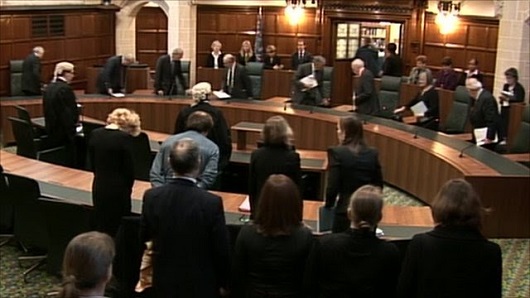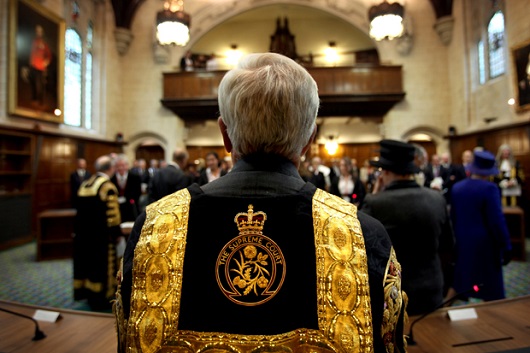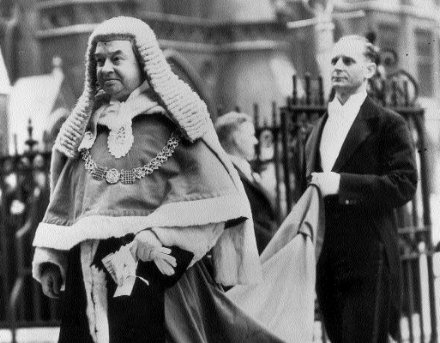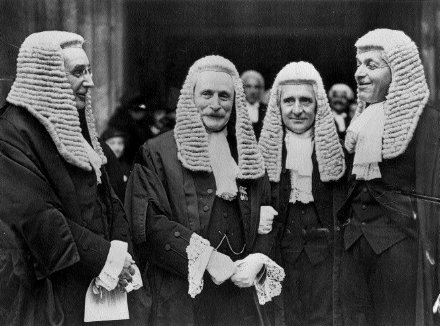Judicial Dress
About Andrew Cusack
 Writer, web designer, etc.; born in New York; educated in Argentina, Scotland, and South Africa; now based in London.
Writer, web designer, etc.; born in New York; educated in Argentina, Scotland, and South Africa; now based in London. read more
News
Blogs
Reviews & Periodicals
Arts & Design
World
France
Mitteleuropa
Knickerbockers
Argentina
The Levant
Africa
Cape of Good Hope
Netherlands
Scandinavia
Québec
India
Muscovy
Germany
Academica
Judging Dress
After some absence, The Sybarite has returned and, in A Love Supreme, he weighs in on the very important matter of judicial dress.
I am, it will surprise no-one to know, deeply traditionalist in such matters. I can see the argument for discarding formal court attire in cases involving children, who might be intimidated by wigs and gowns (as a child, I myself would have been as happy as a pig in the proverbial). But I feel strongly that “work clothes”, whether worn by judges, barristers, politicians or clerks in Parliament, are important. They are part of the persona. You are not Alf Bloggs, you are Mr Justice Bloggs and you are performing an important public role. When you put on the clothes, you put on the role. Of course, I am fighting a rearguard action here – I know that the tide of public opinion is against me. If the clerks at the Table in the House of Commons still wear wigs in ten years’ time, I will be (pleasantly) surprised.

As the Supreme Court was set up in the modish New Labour years, it was inevitable they would dispense with much of the ceremonial. The Justices wear lounge suits to hear cases, though I think in some cases the barristers still wear wigs and gowns. The one concession has been the black-and-gold gowns which the Justices don for special occasions. These are fine so far as they go – and, as observed above, Lady Hale of Richmond likes to accessorise hers with a Tudor bonnet – though they bear on the back the badge of the Supreme Court, which I think looks a bit tacky and smacks of footballers’ names and numbers on the back of their shirts. But they also look a bit odd worn over lounge suits or equivalent. At least successive Lord Chancellors since the role was recast by Blair have retained formal court dress for high and holy days. Mind you, the current occupant, Miss Truss, does look a bit like the principal boy in a pantomime when she wears knee breeches. But fair play to her for continuing to wear the traditional robes, even if the full-bottomed wig seems now to have gone the way of the dodo.
It could be worse. The Supreme Court Justices could wear ghastly zip-up gowns like their American counterparts – you just know they’re made of nylon – over their suits, though I have some time for Justice Ginsberg for adding a lace jabot to tidy up her garb a little. But ceremonial is something that Britain does so well. The Supreme Court could have looked so much better with Justices in gowns and traditional judicial clothing. A wig here and there wouldn’t go amiss.
I couldn’t agree more. Especially on the matter of the badge of the Supreme Court on the back on the gowns, which is simply naff. (See image below.)
But why do the justices of the Supreme Court have (what I think of as) chancellorial gowns anyhow? What is the origin of this style of black-and-gold gown? Did it start with the Lord Chancellor and spread to the Speaker or vice versa? Or have some species of judge always worn chancellorial gowns? The chancellors of universities have likewise adopted it, though its precise form varies from institution to institution, as one might expect in matters of academic dress.
Incidentally, I was speaking with Bob Geldof the other day about Senator W. B. Yeats, about whom Mr Geldof has done a documentary. As we were discussing Yeats’ contribution to the Irish Senate, Mr Geldof mentioned that Yeats had been in discussions with Hugh Kennedy, the Chief Justice of the Irish Free State, about introducing new designs for Irish judicial dress. The results, according to just about everyone, left much to be desired and so the British tradition carried on for the most part. As is so often the case, doing nothing is the least bad option.

Perhaps the Most Vile Sentence Ever Printed in Any Governmental Document in the Entire British Commonwealth of Nations

‘Court Working Dress in England and Wales’, May 2003
This sentence alone epitomises the noxious worldview of the modernist. It is a sentence that pronounces with totalitarian authority a ruling to which it allows no appeal. Tradition, they would tell us, has no inherent value in and of itself. It is nothing but a potential boon to the tourist industry – which is thoroughly reprehensible itself.
Yes, you heinous ignoramuses! There is a justification for retaining wigs and gowns in court on the grounds of tradition alone: thus it is, and ever thus it has been, and ne’er has a soul come to harm because of it! Fat, vile, impudent, ignorant modernist bureaucrats! I believe there is a tradition in the American South involving a self-appointed gang of citizens, a noose, and a tree with strong branches. I couldn’t think of a more appropriate exercise of such a tradition than ridding us of the damnable soul – loathsome, worthless degenerate! – who composed that sentence with all its odious implications.

You may read the detestable ‘consultation paper’ online at what was the Lord Chancellor’s Department but which has since been corporately rebranded by Tony and the gang as the ‘Department for Constitutional Affairs’ with its own catchphrase ‘Justice, rights and democracy’ (sic), lacking the Oxford comma. There are further contemptible utterances in the document; it is not for the faint of heart.
Search
Instagram: @andcusack
Click here for my Instagram photos.Most Recent Posts
- Waarburg October 2, 2024
- A Prize for the General September 23, 2024
- Articles of Note: 17 September 2024 September 17, 2024
- Equality September 16, 2024
- Rough Notes of Kinderhook September 13, 2024
Most Recent Comments
Book Wishlist
Monthly Archives
Categories


